Figuring out the right terrarium substrate may be dirty work, but it’s a critical step in any project.
Think of it as the foundation of your entire ecosystem. It gives your terrarium shape, function, hydration, and nutrients – so it’s important to get the right mix for the job.
Different terrariums have different needs, just like us.
Thankfully, working with a terrarium soil mix (instead of a single material) gives us the flexibility to adapt to any project. Anything you need, we have a super substitution to create a winning formula.
We also have a surefire terrarium soil mix for those who just want it to do the job right out of the bag.
So buckle up for a complete guide on the optimum blends for your next project (along with deep dives on individual elements, too).
Let’s dig in!

Terrarium Tribe is reader-supported. When you purchase through links on our site, we may earn an affiliate commission (at no further cost to you). 💜
Essential Elements of a Terrarium Substrate
Like a good cocktail recipe, every ingredient in a substrate mix is designed to balance and complement one another.
A certain sweetness to the sour, shall we say?
You’re aiming to achieve the ideal balance of water retention, drainage, aeration, and support. Seeing as there’s only ever a single terrarium substrate layer, it all has to be balanced correctly.

Starting with an appropriate base, you can then tailor the choice (and amount) of soil supplements depending on the needs of your chosen plants and environment.
- Base – The base makes up the core of your mix and provides both support and water retention. It typically makes up about half of your overall substrate.
- Structure – These are the more granular materials that provide some much-needed drainage and root aeration for your plants. They help to prevent compaction too.
- Compost – If you’re using completely inorganic components (or you like to give your plants a head-start), you will need to supplement with some organic material.
Fear not; whether you’re a seasoned soil mixologist or you’re new to the indoor gardening game, all will become clear.
DIY Terrarium Soil Recipe
As a starting point, we recommend something like the following:
- 40% Base component.
- 50% Structural materials (ideally a mix of multiple).
- 10% Compost element.
That’ll produce a nicely balanced mix with plenty of drainage and aeration, but it should still be light enough that it’s easy to plant in.
For the structural materials, I tend to favor fine-grade stuff. Super chunky stuff is fine in small amounts but becomes increasingly hard to plant in the more it makes up the mix.
The Top Terrarium Substrate Mixes (ft. ABG Mix)
I get it; not everyone has the time to formulate the perfect mix for every setup.
Thankfully, some tried-and-tested tropical mixes will hit the mark 99.9% of the time. With the classic being the substrate developed by the Atlanta Botanical Gardens – ABG Mix.
It’s something of a gold standard for tropical terrariums.
A fantastic blend of fluffy and chunky ingredients come together to provide a very balanced foundation for your plants. Honestly, it’s great, we’ve used variations of it extensively over the years. Here’s the classic recipe.
- Sphagnum Moss – 1 part.
- Tree Fern Fiber – 2 parts.
- Orchid Bark – 2 parts.
- Peat Moss – 1 part.
- Charcoal – 1 part.

That said, it’s not perfect.
Some of the ingredients (particularly peat moss) are destructive to harvest and non-renewable (and come at a high premium).
We can do better, and that’s why we’ve developed our own terrarium substrate mix.
It’s a precise mix of orchid bark, earthworm castings, coco coir, and horticultural charcoal (biochar). All highly renewable, and formulated with a fine-grade consistency so it’s a better fit for smaller terrariums and it’s easier to plant in.
All the benefits of ABG mix, with none of the guilt. 👌

Premium Terrarium Substrate Mix
Our carefully crafted blend that balances all of your plants’ needs.
Available on the Terrarium Tribe Store.
Understanding Terrarium Substrate Layers
There are two schools of thought when it comes to terrarium layers.
- Separate materials out according to function, e.g. drainage, filtration, and planting.
- Mix everything together and let nature run its course.
I recommend the former in most cases.
Opting for a drainage layer (we recommend leca clay balls as the foundation material) is usually a good idea to provide a healthy watering buffer, but it does reduce the amount of planting space you can use. So for very small terrariums, the latter can be the better option.
Either way, a terrarium only really has a single substrate layer.

So it’s important to get a balanced mix that has its materials well-distributed.
You don’t want all of our water-retentive elements at one side, and your drainage at the other… Formulate it well, and mix it thoroughly and you’ll have no problems.
Now, the rest of this article is for all you DIY-ers. If you’re looking to make/adapt your own mix, we’ll outline all of our recommended materials and how to decide which one is right for you.
10 Ingredients for a Terrarium Soil Mix (DIY)
1. Coir
Coco coir is a fibrous material made from coconut husks, and it’s my favorite substrate base to work with.
It comes in a variety of forms, from dry bricks (that need rehydrating) to bags of coarse chips and finely ground powders – the latter of which is best in my experience.
The larger chips/fibers arguably provide better drainage, but the powder is a dream base to plant in.
It’s super light and fluffy, which means you’re going to get lots of root aeration and tonnes of moisture retention. Plus, it’s not going to compact over time.
What’s not to love?
Well, coir is also popular as a base for its stability and reliability.
As a refined material, it’s not going to break down in your terrarium (at least not for a very long time), and it’s resistant to pests.
👉 Convinced? Check out the coco coir on our shop.
The one caveat is that it contains no nutrients whatsoever. So, to properly support your plants, you’ll have to add a fertilizing element to your substrate, but more on that later.
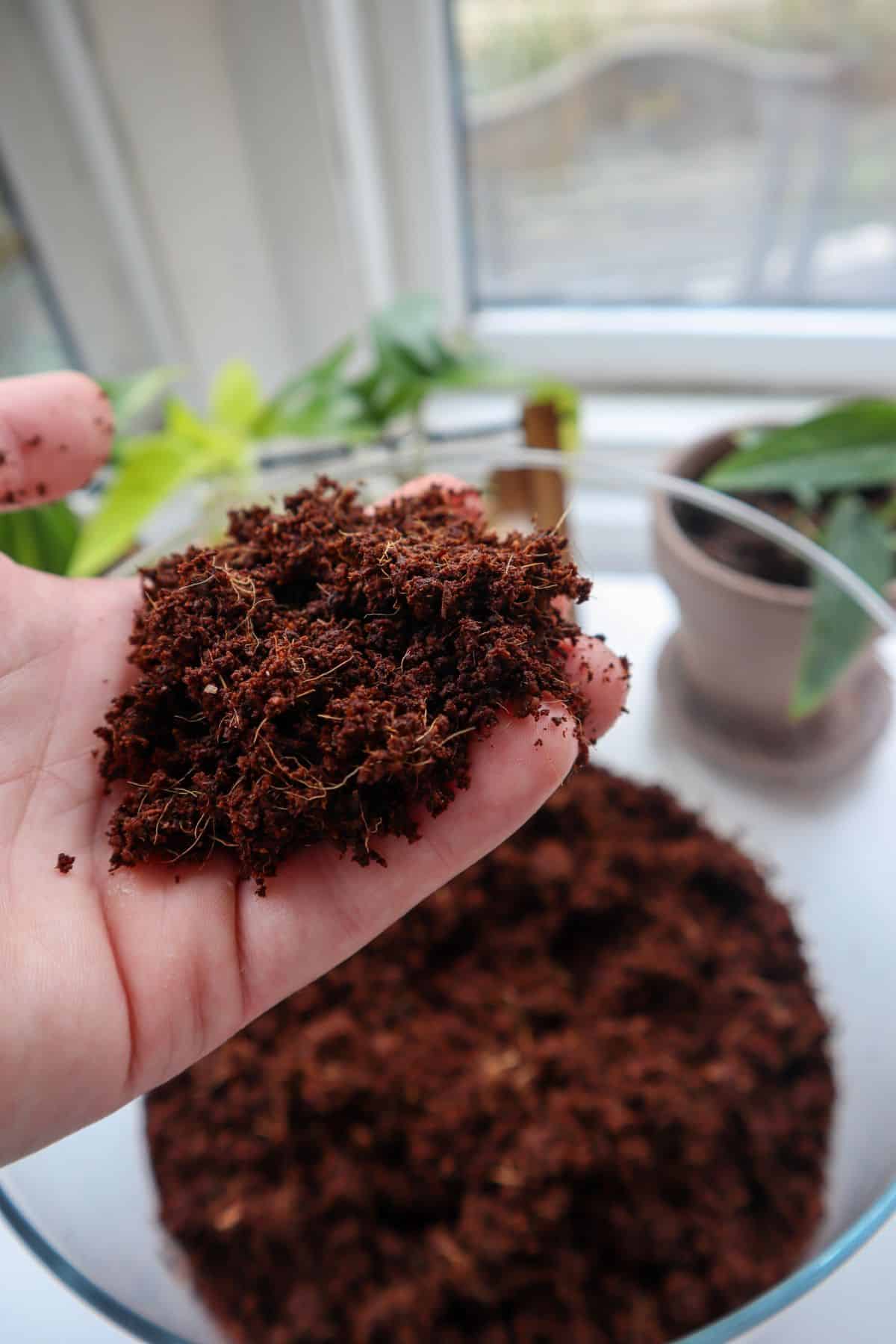
Pros
- High water retention.
- Neutral pH and resistant to decay.
- Natural, (more) sustainable product.
- Pest resistant.
Cons
- Contains no nutrients whatsoever.
2. Sphagnum Moss
Sphagnum moss has become a true staple in the terrarium and vivarium industry.
It’s popular in both its live and preserved forms, but preserved is more common for substrates.
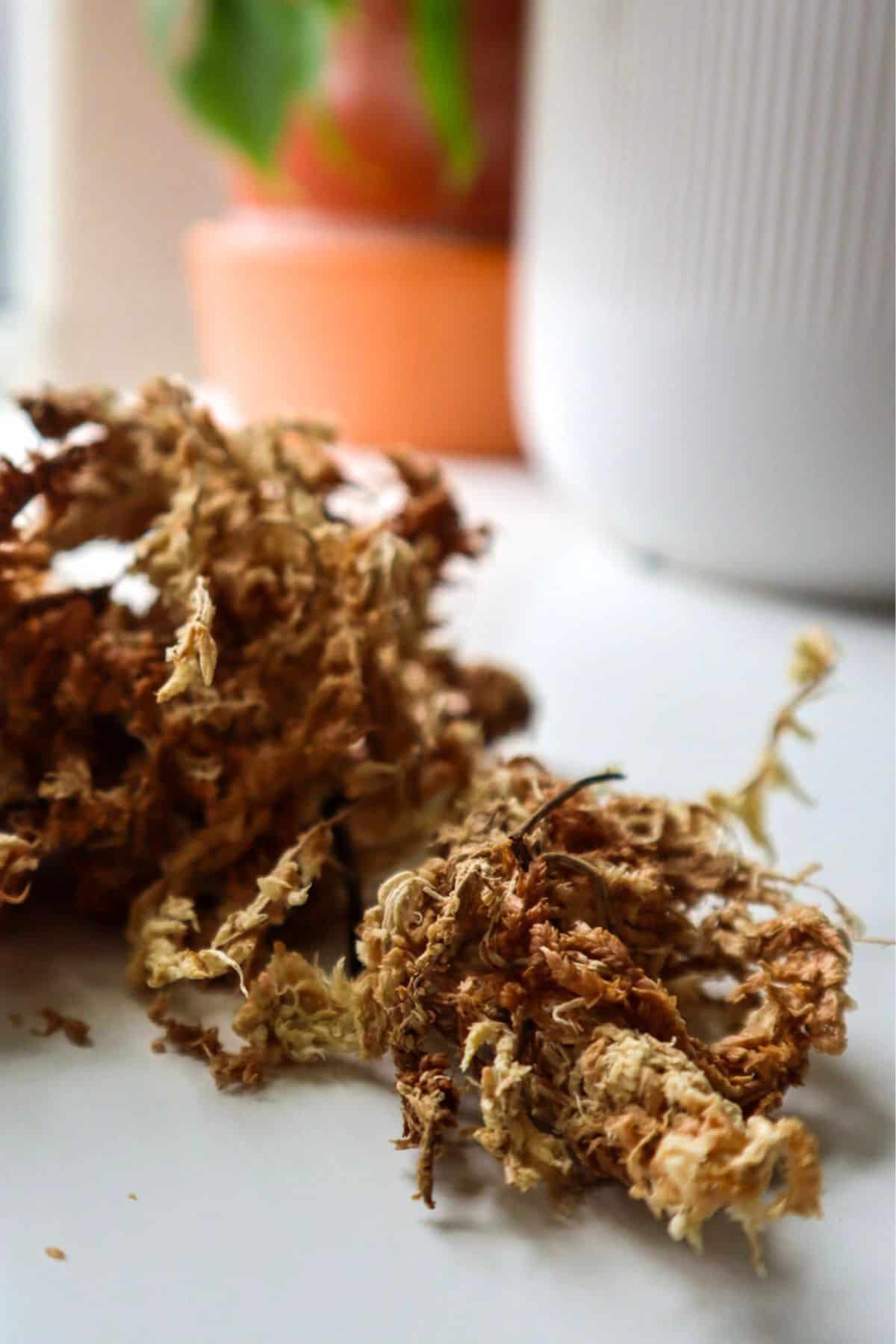
Just like coir, this versatile material is fantastic for terrariums thanks to its unparalleled water retention and its fluffy texture.
Though perhaps just as important is the antimicrobial properties of sphagnum moss, which help to reduce bacterial growth. And therefore slow the rate of decay.
A valuable characteristic in a terrarium environment!
Sphagnum is often used on its own as a growth medium, sometimes as a substrate barrier, and often as a supplement to mixes. It’s arguably a base material and a potential supplement, depending on how you use it.
The main caveat with this one is that it’s not an easily renewable product, so you’ll have to do your due diligence to get it sustainably. Thankfully, ours is super eco-friendly and sustainably harvested!

Sphagnum Moss (Premium Long-Fiber)
High-quality, eco-friendly moss for optimal moisture retention.
Available on the Terrarium Tribe Store.
Pros
- High water retention.
- Slows decay and improves soil health.
- Pest resistant.
Cons
- Contains no nutrients, so not for use in isolation.
- Will eventually break down (but we’re talking a seriously long time).
- Some sources are unsustainable.
3. Aquarium Soil
Aquarium soil is regular soil that has been baked to produce dry pellets.
It’s an interesting option because it has all the minerals and positive growth aspects of regular potting soil but with much better drainage.
That’s because the pellets are round, so they don’t pack together in a uniform shape. They’re also pretty tough, so they’ll resist compaction for years.
Aquarium soil has become a lot more popular recently, and it’s probably the only substrate that can be used on its own. Though on its own, I find it hard to plant in, so I still think it’s best as a base rather than an all-in-one solution.
👉 Grab a bag on Amazon right here and try it yourself.
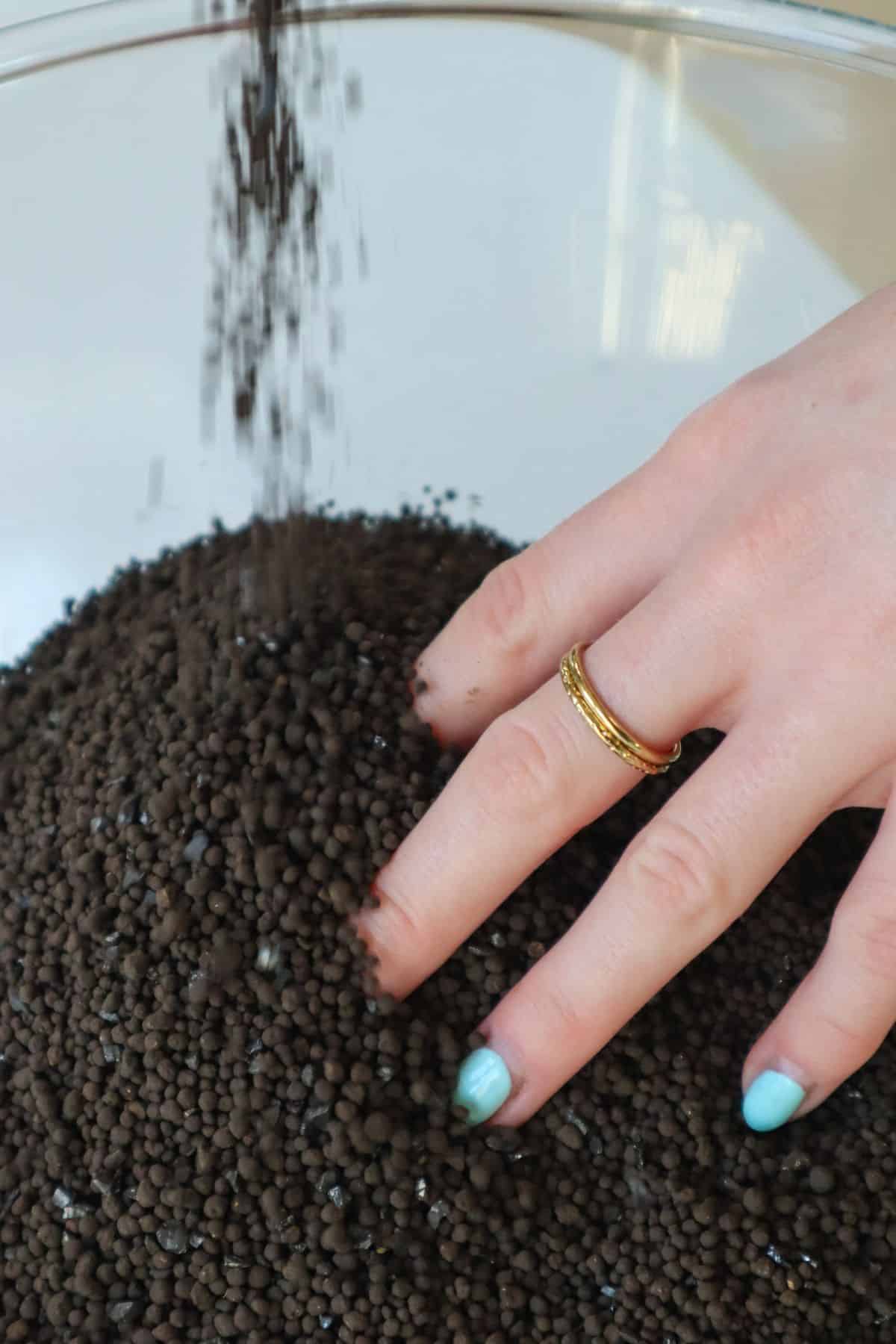
Pros
- It’s stable and won’t compact for years.
- Excellent drainage and water retention.
- A great option for a paludarium.
Cons
- The aesthetic of lots of little black balls may not be for everyone.
- The soil pellets are so tough that I find it a little tricky to plant in sometimes. You can’t simply press a plant’s roots down into it like you would a soft substrate.
4. Orchid Bark
Orchid bark is a more natural way to add granularity and aeration to a soil mix.
It’s a chunky mix of bark shavings (named because it’s often used for orchids; it doesn’t come from them) that helps to provide structure and spaces in a soil medium.
Finding a mix that’s small enough for terrariums is the tricky part; it’s often super chunky.
👉 Check out orchid bark on our shop.
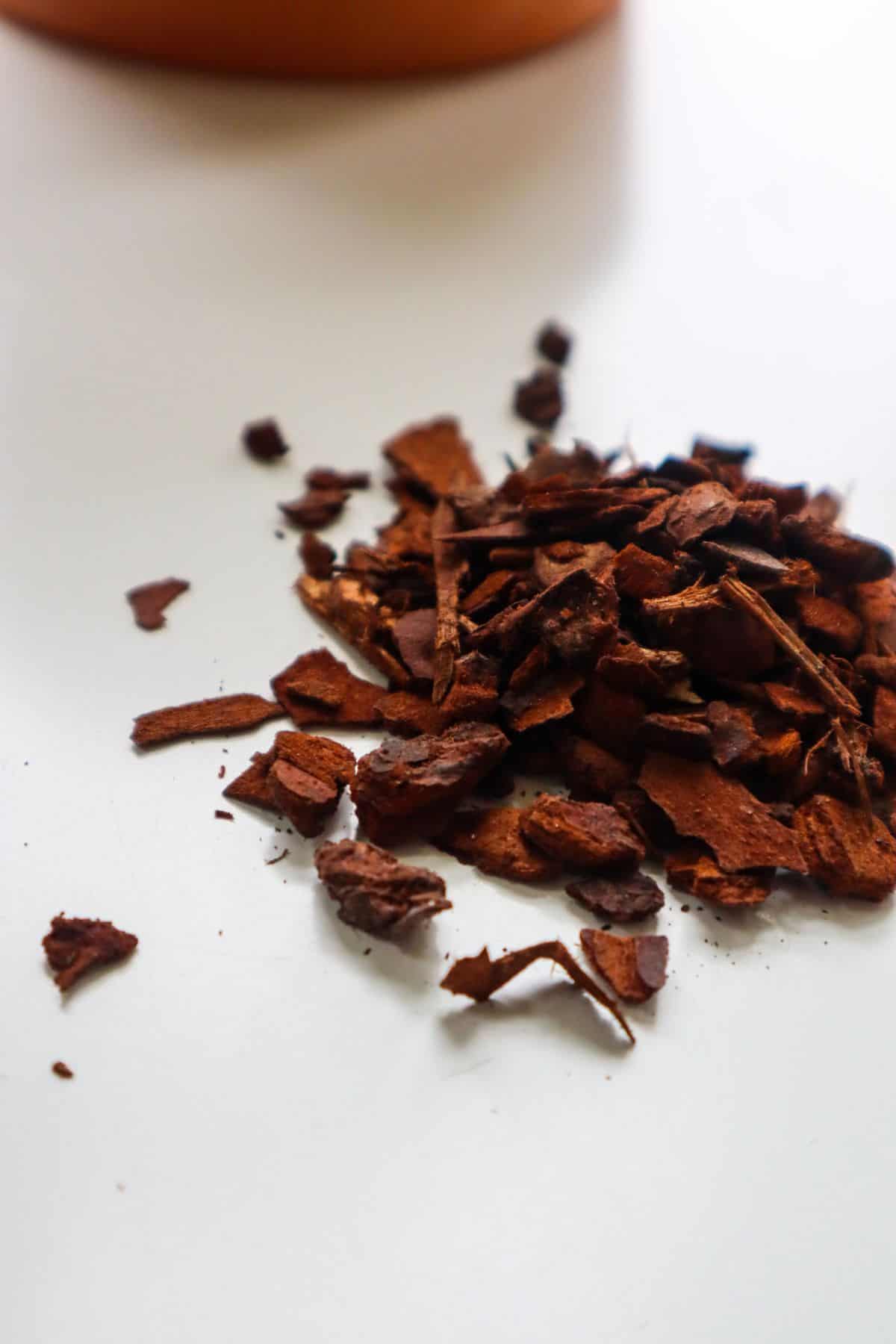
Pros
- All natural, sustainable material (that actually looks natural!).
- Great for root/soil aeration.
- Brings some degree of water retention.
- Bioactive material.
Cons
- Arguably more susceptible to rot, seeing as it’s a natural product.
5. Pumice
Pumice is a type of volcanic glass that’s more of a smooth gravel.
Often used in the bonsai industry, pumice has a lightweight honeycomb structure and an open porous exterior, making it an excellent soil aerator and moisture retainer.
A wonderful little rock with a lot of versatility.
There are a tonne of different kinds of pumice in all manner of sizes, colors, and compositions. Some of it can actually be quite soft/brittle, which I wouldn’t recommend if you’re using it to provide structure, too.
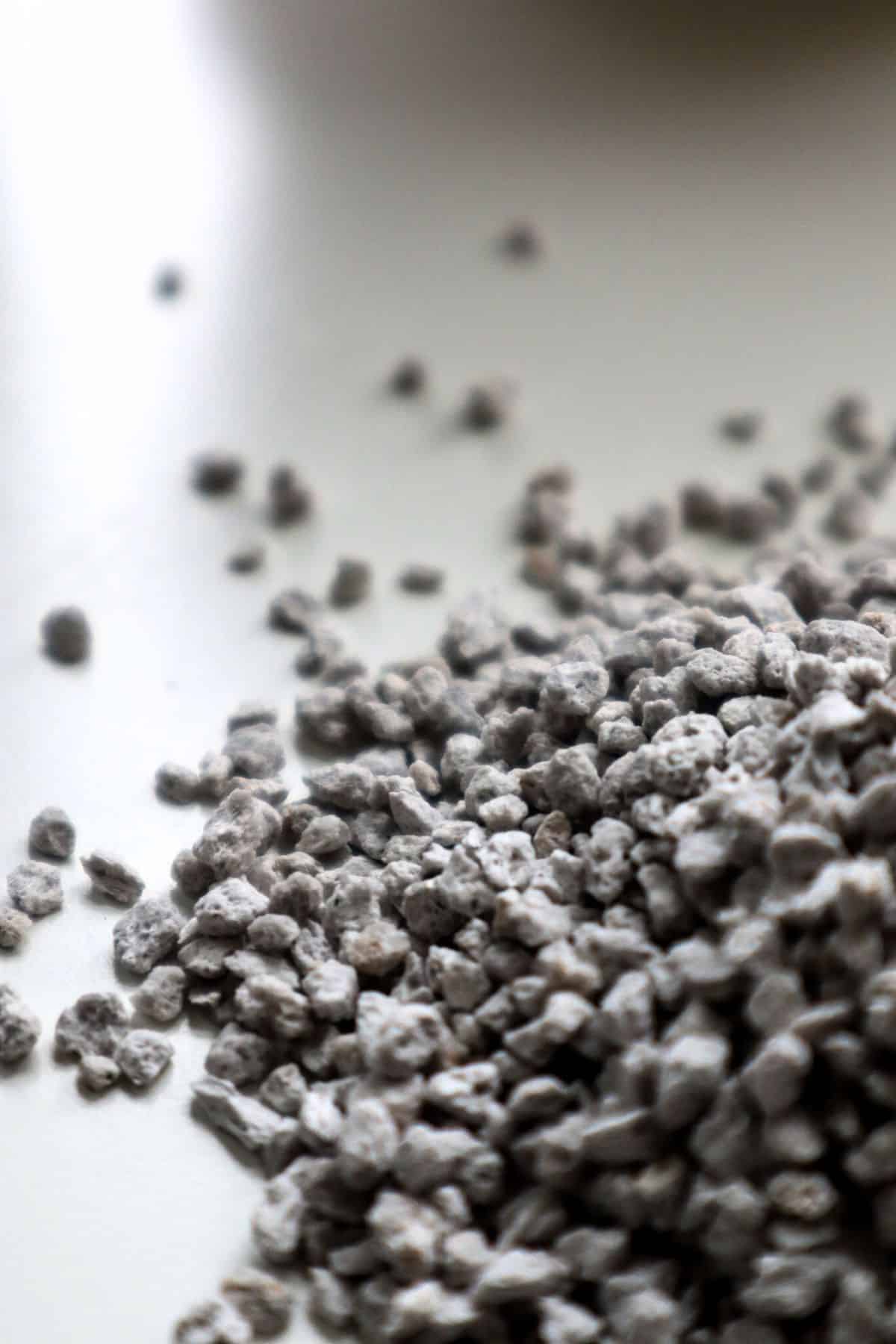
Pros
- Great for aeration & water retention.
- Good drainage.
- Natural looking.
- Lasts indefinitely.
Cons
- None to speak of.
6. Lava Rock (Scoria)
As you might imagine from the name, lava rock is another volcanic horticultural material.
Sharp, dark, and non-uniform, it can provide some real structure to a mix. Though it’s heavier than pumice, it still provides plenty of aeration and water retention.
The large surface area can also help promote beneficial bacteria in bioactive setups. I’ve used lava rock as both a drainage layer and a substrate element, and I’m a big fan.
👉 I prefer aquarium-grade crushed lava rock, which is nice and small in grain size.
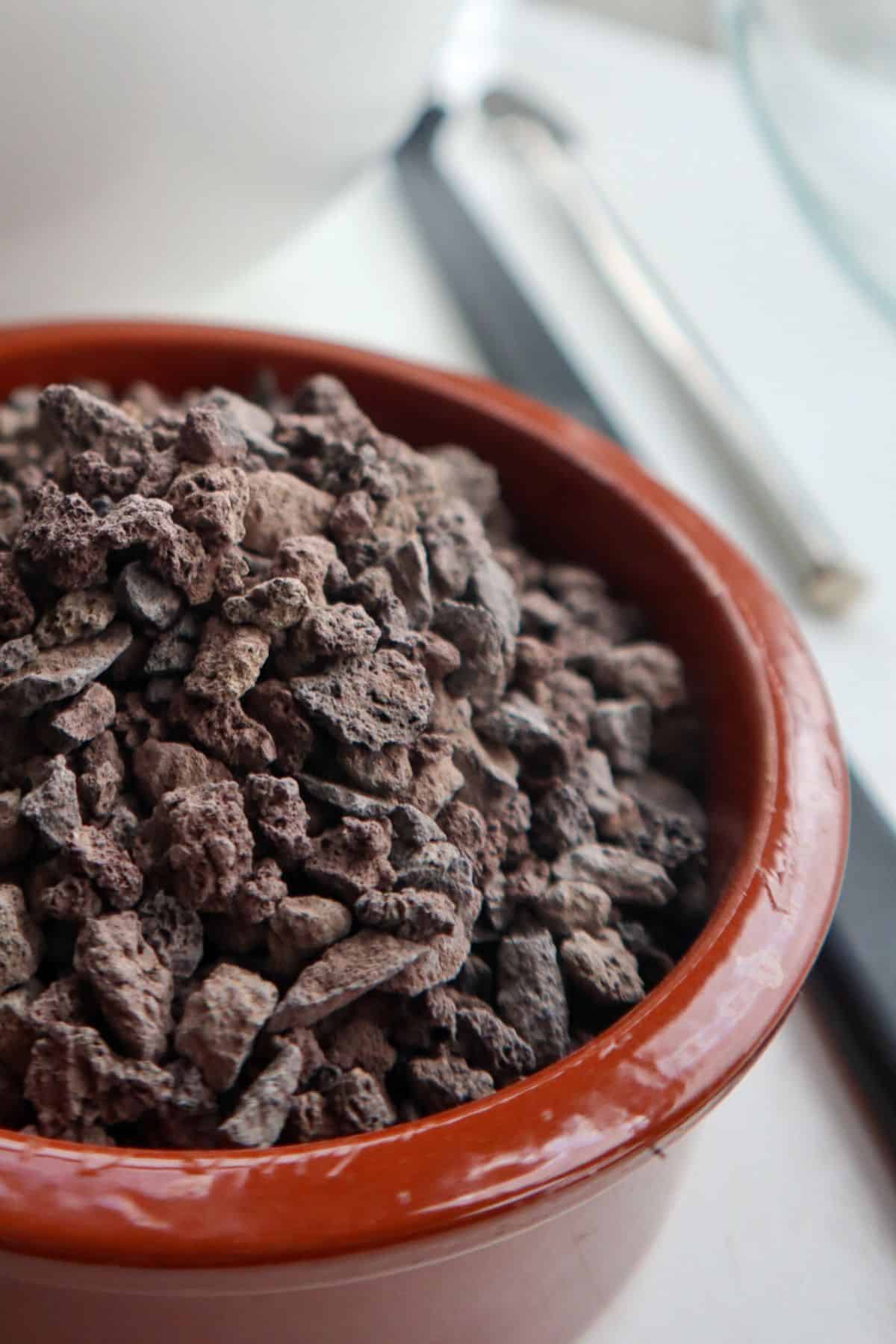
Pros
- Great for aeration & drainage.
- Can be used to wick water upwards.
Cons
- Difficult to find small particle sizes.
7. Earthworm Castings
If you’re running with pure coir as your soil base, you’re going to need to add some nutrients to your growth medium.
I’d be wary of adding any homemade compost that may contain any rotting material, and I’d definitely opt for something packaged where possible.
Earthworm castings are a great, readily available solution.
A nice way of saying “worm poop,” worm castings are compost produced through the feeding actions of earthworms.
It’s an all-natural fertilizer, which is also well-draining and has a high water-retention capacity.
👉 Grab a bag of earthworm castings here.
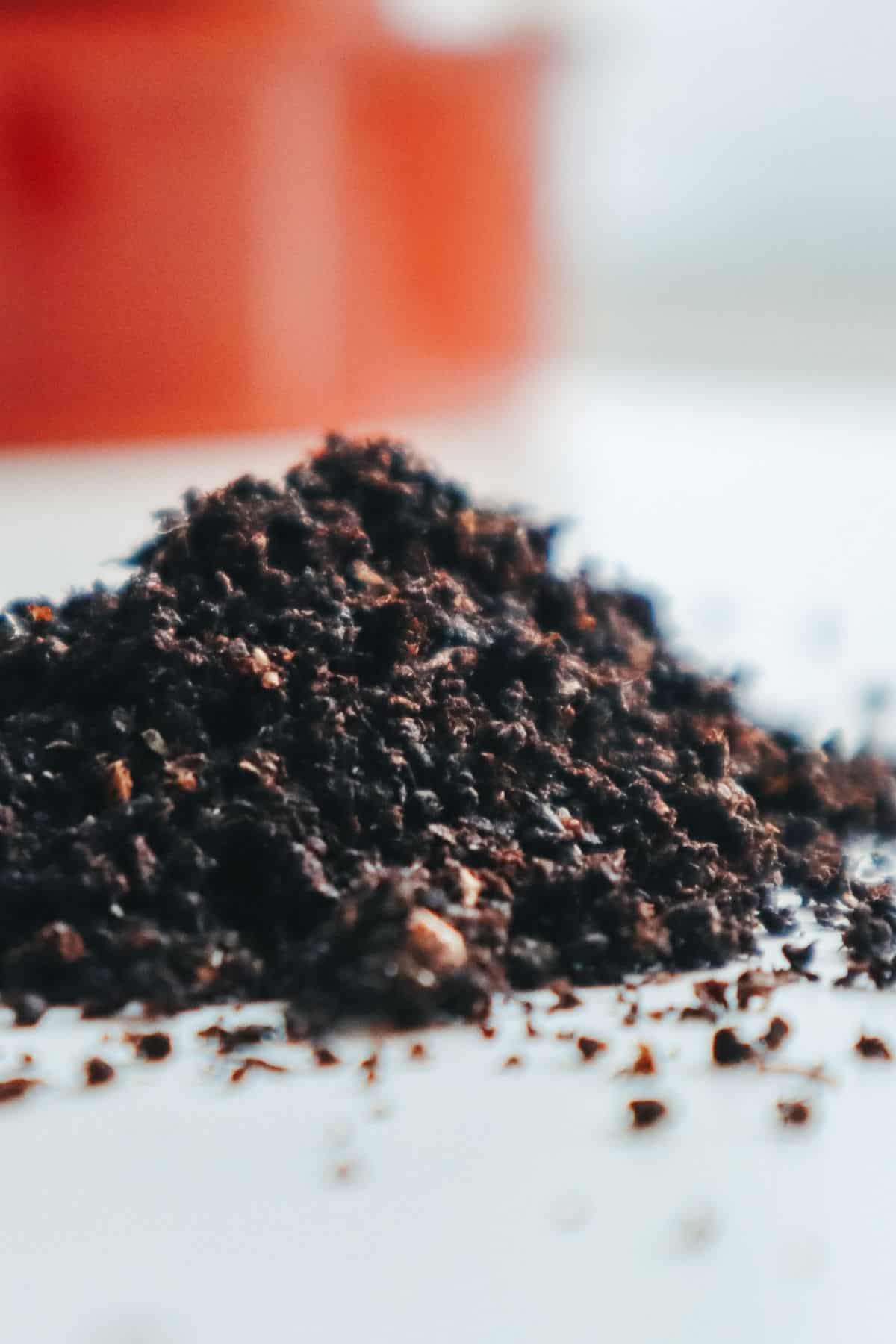
Pros
- Eco-friendly.
- Slow-release nutrients vs liquid fertilizer.
- Has moisture-retaining properties.
Cons
- None!
8. Charcoal
Charcoal has been a horticultural staple for a long time, but its use in terrariums is a lot more varied.
Thanks to its highly absorptive nature, it’s able to bind to terrarium contaminants – making it an often touted “cleaning” material. Though the effectiveness of this action isn’t easily quantified, it may prove to be a lifesaver.
Plus, charcoal still brings other positive qualities to a substrate mix.
It’s able to retain moisture thanks to its porosity and is often described as being able to store and provide nutrients to plant roots.
It comes in a variety of forms, but horticultural charcoal and activated charcoal are likely your best bets.
Smaller chunks are the easiest to distribute as part of a substrate mix, or you can opt for larger pieces if you’re using them as a dedicated layer.
👉 See the activated charcoal on our shop.
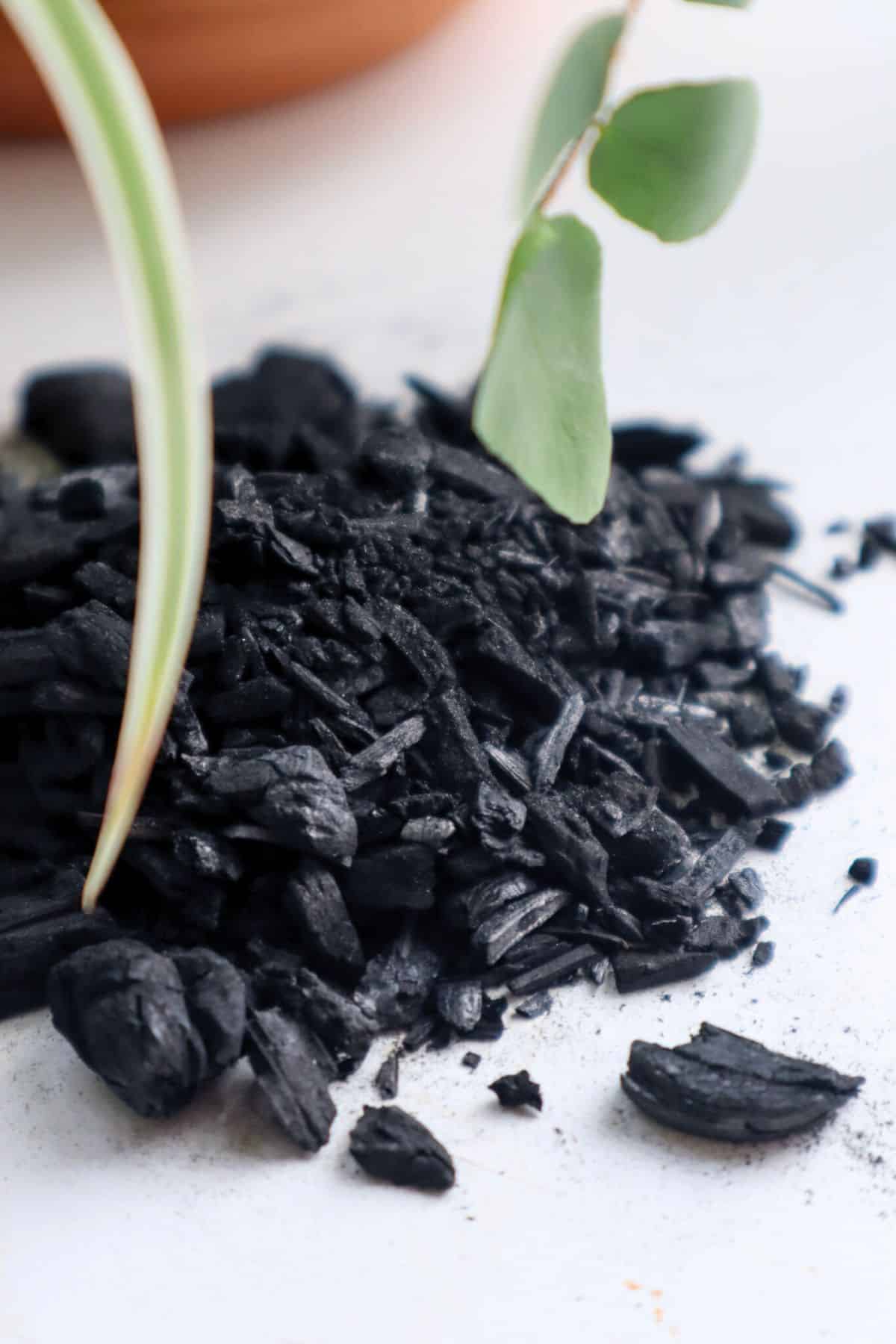
Pros
- Odor and toxin binding capabilities.
- Moisture-retentive.
- Excellent soil aerator.
Cons
- Activated charcoal can be expensive.
- Can spike soil pH in large quantities.
9. Sand
Sand can be an easy addition to your substrate to increase its aeration and drainage.
Coarser horticultural sand will be best, but any sand will do (barring sand from the beach).
Obviously, if you’re going for a desert terrarium, you’ll have a much higher proportion of sand. The same goes for any cactus or succulent mix.
Personally, I prefer to use black sand where possible. That way, it’s less visible in the substrate, and the darker substrate contrasts better with green plants.
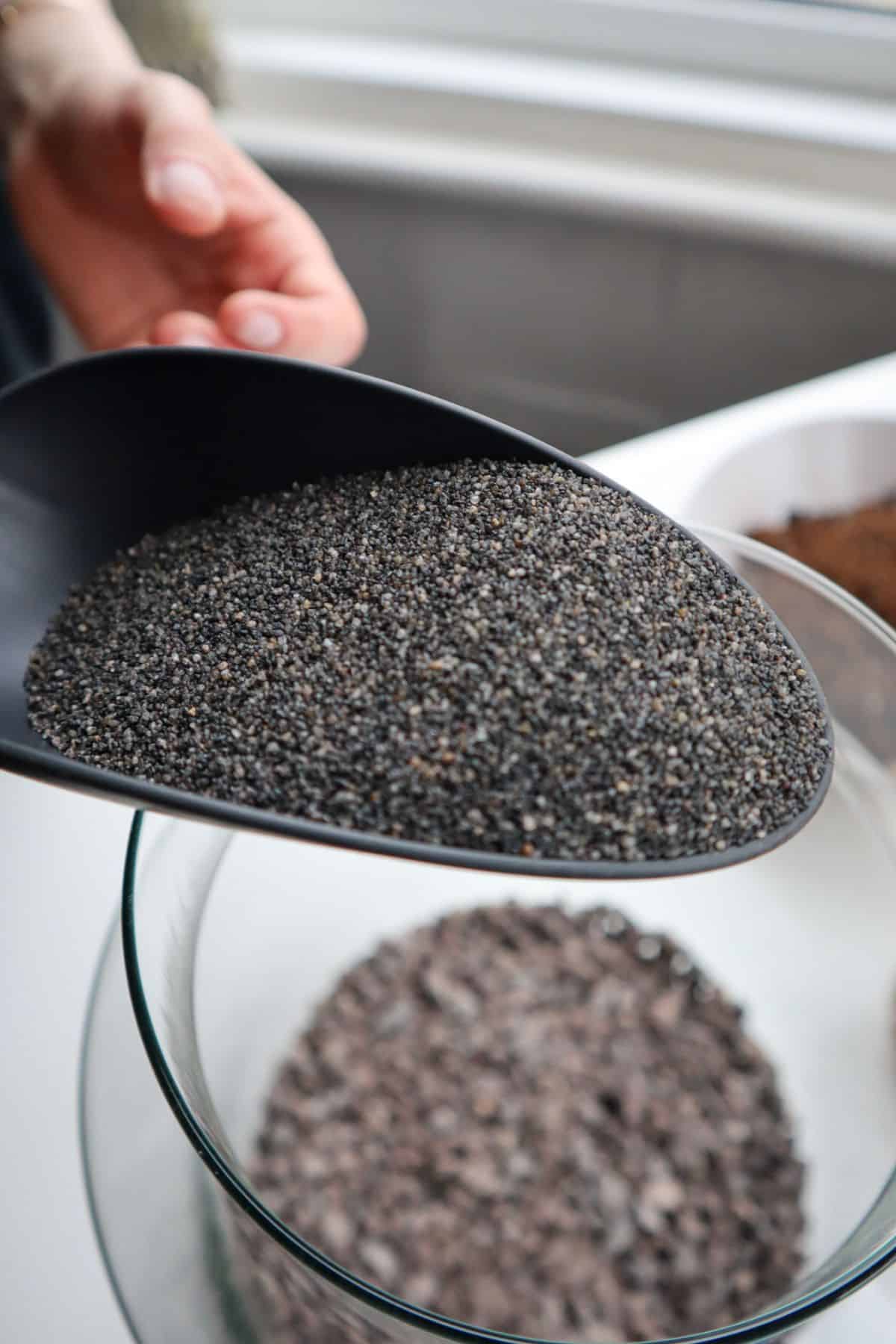
Pros
- Great for drainage and structure.
- Maintains a nice, fine substrate consistency.
Cons
- Doesn’t offer any other value beyond drainage.
10. Tree Fern Fiber
Tree fern fiber is an interesting material in that it looks like lots of tiny fine twigs.
Kind of like how you might stack branches on a fire; it brings a unique structural dynamic to a mix.
Though, despite being a founding member of the ABG mix ensemble, tree fern fiber doesn’t see as much use as other materials on this list.
Mostly because it’s difficult to source (even more so in a sustainable way), but it’s tough to find a good substitute for, too.
👉 I’d recommend Fernwood New Zealand tree fern fiber for a sustainable source.
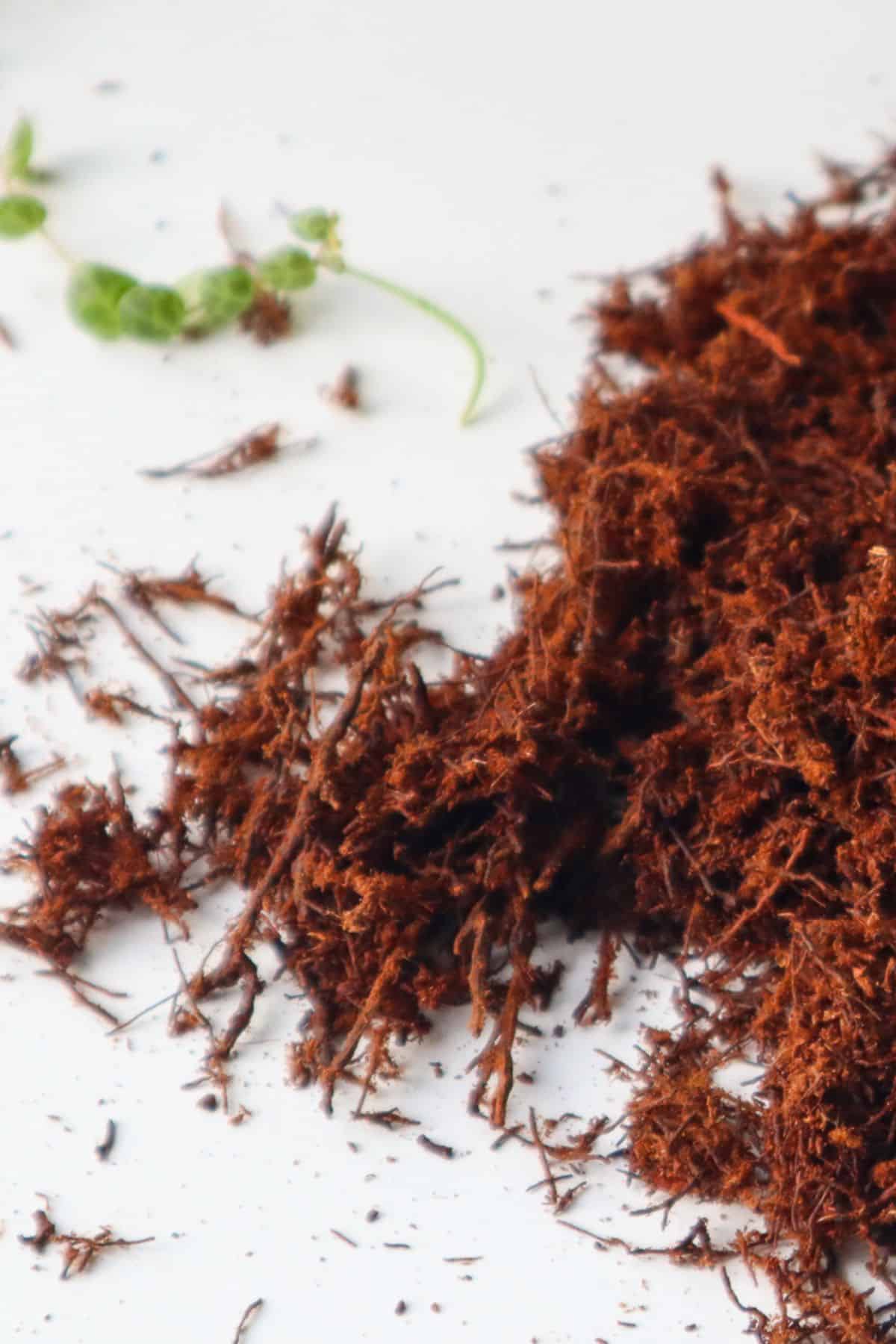
Pros
- Brings a unique structural quality to a mix.
- Natural product with a natural look.
Cons
- Can be expensive and difficult to source sustainably.
Bioactive Substrate for Terrariums
A bioactive substrate is one that’s optimized to support terrarium microfauna and microflora.
That’s tiny custodian critters like isopods and springtails and beneficial fungal and bacterial soil cultures.
It typically follows the same principles as a regular terrarium substrate mix but favors a few kinds of ingredients to maximize “bioactivity” and support more life.
- There’s often a higher proportion of organic elements for isopods to eat (e.g., more earthworm castings or crushed-up leaf litter).
- More charcoal, or equally porous material – as it’s easy for microbial cultures to colonize.
See how to make a bioactive substrate for the full breakdown
Now, Over to You
What’s your preferred terrarium soil mix?
I’d love to hear some specific examples of what you use for different plants. We’re always looking to explore other ingredients (e.g. molar clay) and other mixes (e.g. arid/desert terrarium mix).
Share them in the comments below.

Hi ! We are are making our substrate with 1/3 bark, 1/3 potting soil, 1/3 sand and also add some activated charcoal.
However we can not get a hold of spaghnum moss and we also feel like the sand is a little bit too much.
Any advice :)?
Hi Cedric, the sand and the bark should help a lot with aerating the potting mix, but you might find your substrate to be a little heavy with that ratio. If you can’t get a hold of sphagnum moss, coconut coir would be a good substitute to keep the mix a little lighter and fluffier.
Hey! I’m working on my first terrarium build after finally deciding what to do with an antique Edwardian case I have, and I discovered some greenhouse frogs that made their way from my grandmother’s backyard, to my closed patio via an epidendrum orchid with moist soil. Theyre so tiny, and I think they’d like the finished product and getting as many bugs as they can handle. So, I’ve waterproofed the wooden case and decided to use Hydroballs and larger pebbles, charcoal (of course), and aquarium soil. I chose aquarium soil because of the clean compact pellets. Now that I just discovered ABG mix, I wonder if I should purchase a bag, or maybe add coir for some softness?
Hey Brittany, your first terrarium sounds like an amazing project! I’ve been experimenting with aquarium soil for the same reason, I really liked the idea of a uniform soil solution but personally I found it quite awkward to plant in on its own. I’m looking to make it into a custom mix for my next build, and coir is definitely on my list to add to it. I’m afraid I can’t speak too much on creating a good habitat for frogs as I’ve no experience of keeping animals, but I do know that ABG mix is pretty much the go-to substrate for vivariums, so I would imagine it’s a much better fit for animals than aquarium soil.
1/4 coir, 1/8 compost, 1/8 topsoil. 1/10 or less of: charcoal, sand, spagnum moss, vermiculite, worm castings, hay. Suspend that mix on gravel, separated by screen. Cypress mulch and shredded leaves on top of the mix. What do you think? Any suggestions?
Overall this sounds like a great mix for a vivarium, but if it’s just for plants there’s a few things I’d probably remove. The compost and mulch are both going to rapidly decompose, and if you’re already using worm casting you won’t need that level of fertiliser (or any at all really). Everything else sounds just fine, you’ll have plenty of water retention and drainage with a mix like that. Not sure on the hay now that I think about it. Hope that helps!
I’m thinking of integrating live plants into my corn snakes tank. The plants being used aren’t super water-loving. This is the mix that I was told to make: 50% top soil, 25% sand and 25% coir, sphagnum moss, and vermiculite. Would you add/change anything to this mix for the most effective plant growth?
Hey Kelly, I can’t comment on how suitable it is for animals, but it’s a reasonably balanced mix that should be fine for more drought resistant plants. Personally, I’d reduce the % of top soil as it can compact over time.
Hey! I’m starting a 70 liter paludarium with a mixture of ferns (maiden hair etc) and emersed aquatic plants (anubias, java ferm, mosses).
It will have about 2inches of water at the bottom under a drainage layer and a filter and fogger.
Was thinking 1/3 to half of aquarium soil (oliver knott), 1/3 spagnum moss and the rest orchid bark.
Does that sound ok?
Thanks!
Hey Sarah! Aquarium soil is a good all rounder – both terrestrial and aquatic plants can grow in it – so it’s hard to go too wrong with a mix using that as a base. Assuming the sphagnum and orchid bark are only being mixed in with the dry aquarium soil above the water line, they should hold up well.
I am going to make my first terrarium. I have read so much it has only serviced to confuse me. What do I need to mix in with the store bought potting soil. I am going to purchase 10 terrarium plants from esty. Ferns, a dwarf palm, polka dot plant, etc. Please spells things out for me. I guess my main concerns are adding the proper mixture for nutrients, drainage and whatever else is needed. I feel totally confused from all I have read. Can you help me? 🙂
Hey Des, I’m sorry to hear you’re struggling with your terrarium plans. If you’re set on using potting soil, you’ll likely want to add something like coco coir and sphagnum moss to “fluff up” the mixture, plus something like orchid bark for drainage and root aeration. Feel free to join the Facebook group if you have more questions! 😀
You have a FB page? 🤩 I’ll join 💯
Thank you for all your advice. It’s great 👌
I’m a beginner in infant stage when it comes to terraniums but I am determined and have read so much on the topic, I dream about it 😂😂
I found your advice in this forum the best and easiest to understand so far 👌
Birgit from Melbourne, Australia
Hi Dan! Thank you very much for this interesting article.
I made some terrariums using potting soil, sand, pine bark and sphagnum moss. The texture is fine but I got the substrate flies in all of my closed terrariums, and it’s becoming quite difficult to get rid of them.
I’ve been reading that potting soil is not ideal for closed terrariums. Do you think that this could be the reason why I get this black flies?
Thank you!
Hi Gustavo, yeah I’d say it’s most likely the potting soil – particularly if it has been open for a while. That being said, if the pine bark is damp and open it could be that too.
Hello! I just created my first closed terrarium, and would like to add springtails to it soon for mold control on some driftwood. I used aquasoil leftover from a planted aquarium. Will springtails do all right in that kind of substrate?
Thanks for all the helpful articles! This site has been an awesome resource so far.
Hi Adrienne, I’m so glad you’re finding the site useful. 🙂 Springtails and aquasoil have been fine in my experience. The way the round pellets lie seem to leave plenty of space for them to maneuver.
Hi Dan. I’m a very new (but very keen) terrarium creator and your site looks fantastic with lots of clear, balanced and useful advice.
I want to create an (Arizona-ish) red dessert setting for an open cacti, succulent and mini scorpion terrarium and would love to cut up red house bricks as miniature rock formations (and the smaller bits to mix with my substrate). Are old, red house bricks safe to use for these plants in this situation?
Thanks
Nathan
Thanks so much for the kind words Nathan! As far as I know, house bricks are just fired clay and should be absolutely fine with plants.
Hi, I just wanted to say that this is a fantastic article – thank you so much!
Hi!
I am SO glad I found this site! so much helpful info.
I am a complete NEWBIE, never ever done a terrarium before and while working on a centerpiece for a fundraiser I fell in love with succulents, moss and something I would never have thought was so cool. Lichen. I bought British Soldier and Pixie Cup Lichen and have NO clue how to set up a terrarium to keep them alive. Is this something you can help with?
Robin
Hi Robin, our How to Make a Terrarium article is the best place to start.
Wondering when you might choose to use coco coir vs sphagnum, or both? They seem to accomplish a very similar purpose in the mix
They’re both super water retentive, but coir has the consistency closer to a typical planting medium so it’s better as a base for a mix.
Hi Dan,
I’m very new to this but I’ve always been incredibly interested in the idea of actually creating a self-sustaining ecosystem and your website does an incredible job of breaking down what you need to do that. My only issue that I am confused on is how to create the substrate. My question is kind of all over the place, but do you layer the substrate or is it thoroughly mixed?
Thank you very much!
Thanks for the kind words Conner! The substrate should generally be a mix of several ingredients, thoroughly mixed so they have a good distribution of the different qualities (an even amount of water retention and draiange really). Then that mix should be added as a single layer.